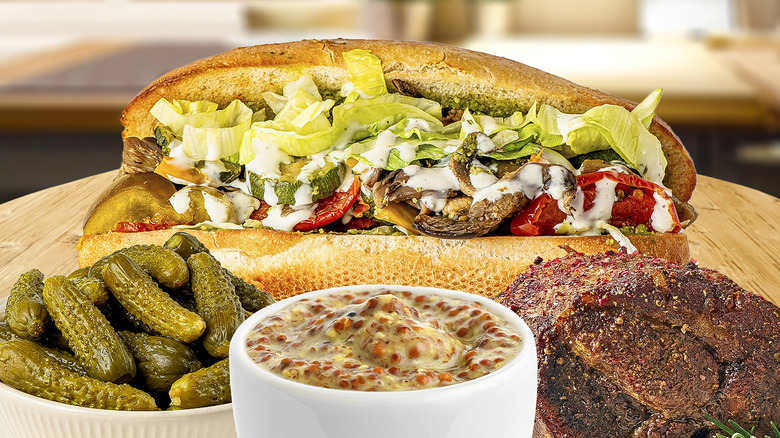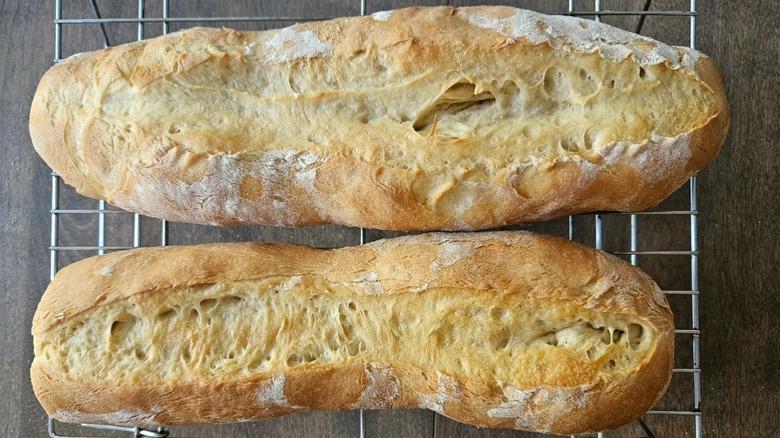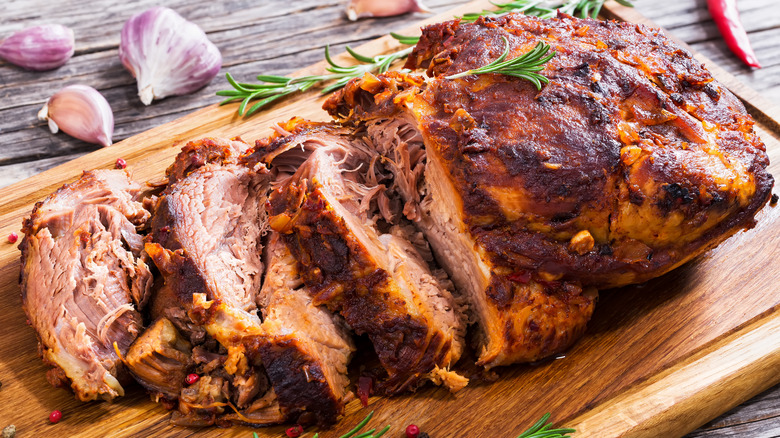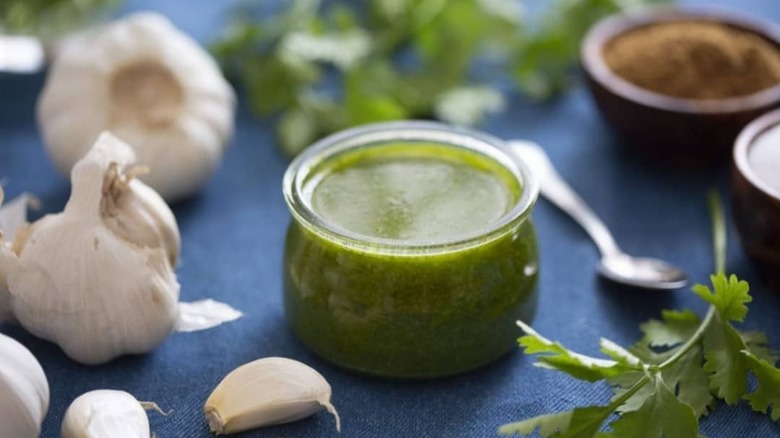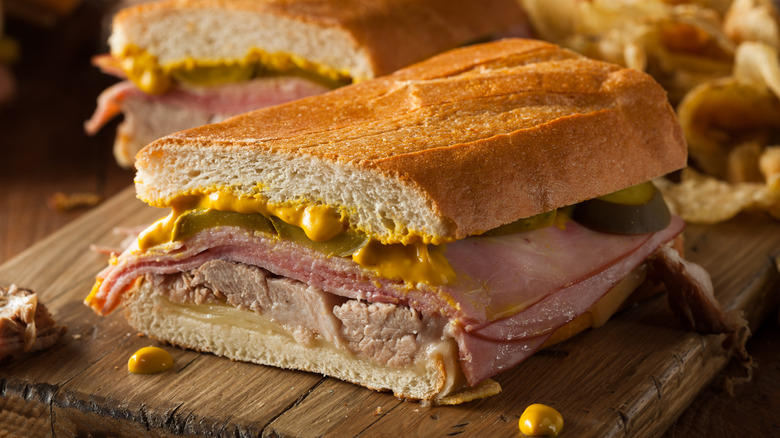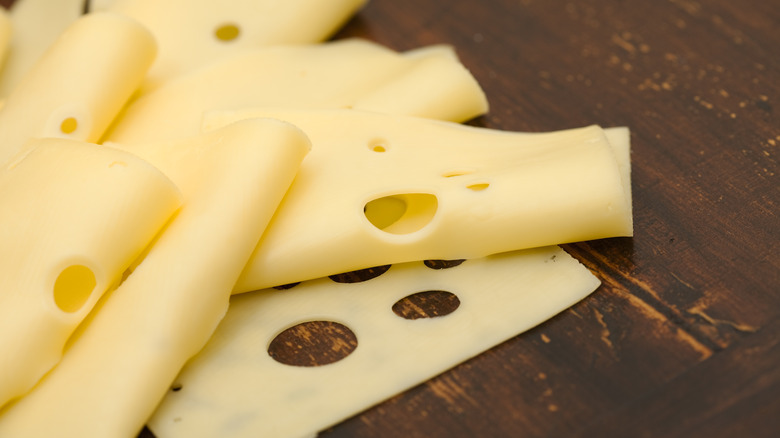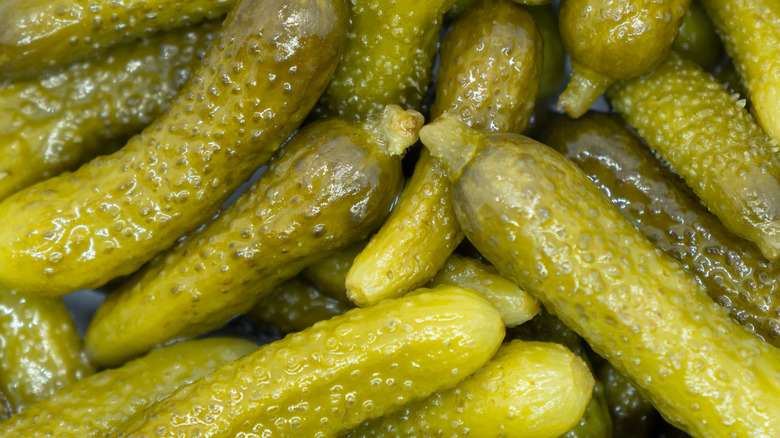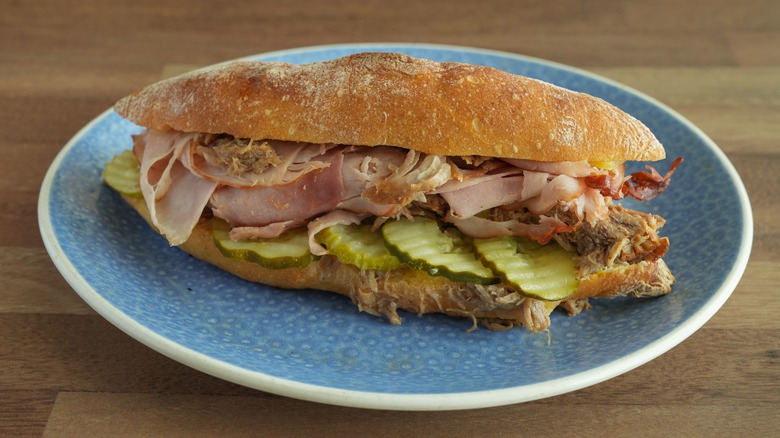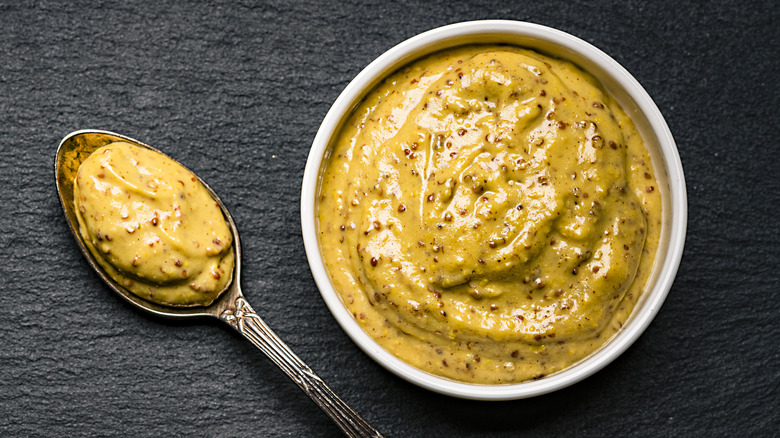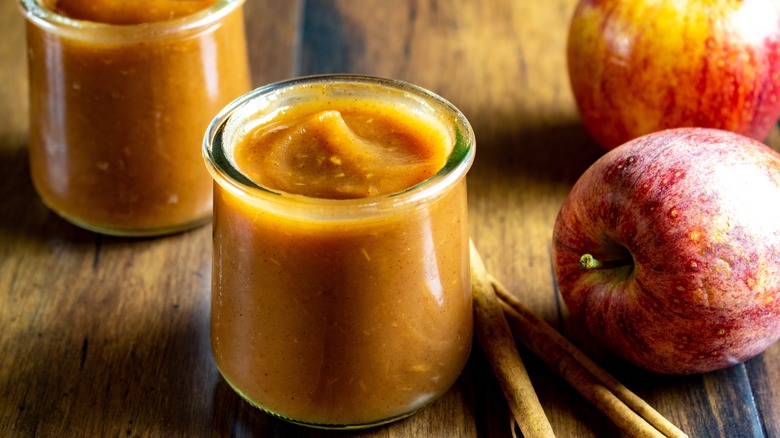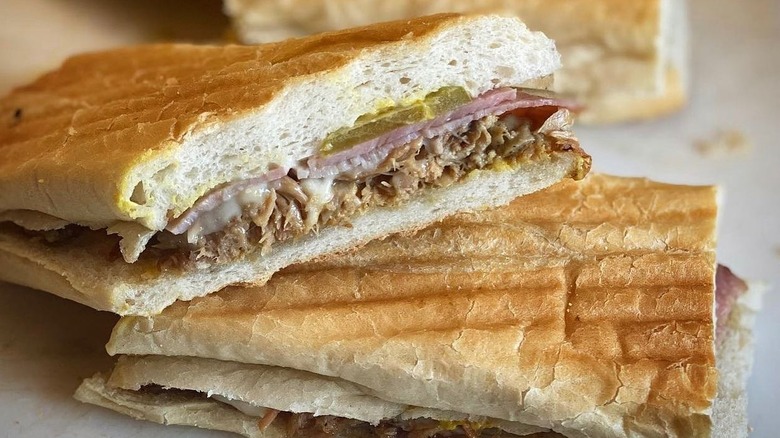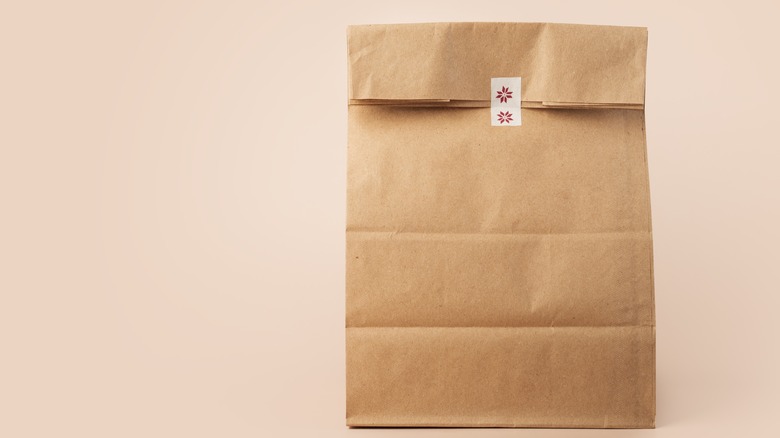12 Tips For Perfecting The Cuban Sandwich
The Cuban sandwich, or "Cubano," is more than just a sandwich — it's a culinary icon. Famous for its savory blend of roasted pork, ham, cheese, pickles, and mustard, this sandwich has become a beloved dish across the globe. However, mastering the perfect Cuban sandwich isn't quite as simple as tossing ingredients together. Every detail, from the bread to the pork to the way it's pressed, matters. The right techniques and ingredients can transform a decent sandwich into an unforgettable one. To uncover the secrets of the perfect Cubano, we turned to Chef Carlos Perez, executive chef at The Corner Restaurant in Connecticut. With his Cuban heritage and extensive culinary experience, Chef Perez brings both authenticity and expertise to the table.
In an exclusive interview with Chowhound, Chef Perez shared 12 essential tips to help elevate your Cuban sandwich game, ensuring every bite is bursting with flavor. Follow his advice, and you'll be serving up Cuban sandwiches that are sure to impress family, friends, and your own taste buds.
Use Cuban bread
The foundation of any great Cuban sandwich starts with the bread, and according to Chef Carlos Perez, Cuban bread is definitely the way to go. "Cuban bread is essentially your basic crusty white bread, such as a baguette," says Perez. What makes it stand out? "Cuban bread is baked with a palm leaf to create its signature split top," he explains. It's also made with lard, which gives it that signature soft, velvety texture on the inside.
Don't worry if you can't find authentic Cuban bread. Chef Perez assures that other similar crusty white breads can work in a pinch, as long as they have a good crust and a soft white interior. The bread should also be "shaped in that baguette/demi baguette sort of fashion," he says. This way, it holds the fillings without falling apart and maintains its structure. The crust plays a key role, needing to be firm enough to handle the juicy pork and pickles but soft enough to bite into easily. With the right bread, your sandwich will avoid being soggy or tough, offering just the right texture from start to finish.
Go with pork shoulder for maximum flavor
When it comes to the meat in your Cuban sandwich, don't make the mistake of going with just any old pork. You have to choose the right cut. Chef Carlos Perez recommends using pork shoulder for its rich flavor and texture. "The best cut of pork for a Cuban sandwich is hands down the shoulder. It's a working muscle, which means it has lots of flavor to begin with, but being a muscle, it also has to be cooked for a long time to thoroughly break it down and make it tender," he explains. This slow-cooking process results in melt-in-your-mouth results, making it ideal for the hearty Cuban sandwich.
For those who are short on time, pork loin can be a quicker alternative. Unlike pork shoulder, it requires less cooking, but there are a few steps to follow for best results. "I've used pork loin, but only cooking it for a much shorter amount of time, letting it chill, and then slicing it thin, sort of sandwich-meat style, for Cubanos," Chef Perez says. This method offers a lighter texture, but still complements the classic Cuban sandwich ingredients well.
Ultimately, "both come out fantastic," notes Perez, but "the shoulder is more traditional, and I think has a slightly better flavor." If you're aiming for a truly top-of-the-line Cuban sandwich, slow-cooked pork shoulder reigns supreme.
Marinate the pork in a zesty mojo
The key to truly flavorful roast pork in a Cuban sandwich lies in the marinade, and traditional Cuban mojo delivers that signature zesty punch. "I always make mojo when cooking Cuban food. It's essentially a super garlicky citrus marinade," Chef Carlos Perez explains. While every family has its own twist, Chef Perez's version "includes garlic, orange juice and zest, lime juice and zest, cilantro, mint, cumin, and a few other ingredients." This vibrant mix of flavors not only infuses the pork with a delightful tang but also adds herbal notes that brighten each bite.
"A nice, slow 5-6 hour cook on the shoulder with that marinade makes for great eating," mentions Perez. By allowing the meat to cook slowly, the flavors meld beautifully, resulting in a tender, juicy meat that practically melts in your mouth. To make the sauce, you can easily stick with traditional mojo ingredients, which include lots of garlic, sour orange juice, oregano, cumin, and fresh herbs like cilantro and mint. Alternatively, feel free to experiment with your own twist, where you might swap in lemon juice for the sour orange or add a hint of jalapeño for some heat. Either way, marinating the pork in this flavorful base will take your Cuban sandwich to a whole new level.
Layer the ingredients correctly for a balanced flavor
Building a Cuban sandwich may seem straightforward, but there's an art to layering the ingredients so that every bite is perfectly balanced. If you don't layer your Cubano correctly, you might end up with an uneven distribution of flavors, with one ingredient overpowering the rest. Each ingredient plays its role, from the sharpness of the mustard to the creamy melt of the cheese. Chef Carlos Perez has a tried-and-true layering method that delivers the perfect bite every time: "I typically lightly mustard both sides of the bread, then ham on the bottom, roast pork, pickles, cheese, top bread, butter it, and press until golden brown."
The mustard and butter on the outside of the bread help it crisp to a golden perfection without burning, while the layers of ham and roast pork create a sturdy base that supports the pickles and cheese. Stack the ingredients in a staggered fashion to help the sandwich hold together when pressed and make each mouthful enjoyable. Mastering this layering technique will help create a harmonious blend of flavors, all the while keeping the sandwich intact.
Always use Swiss cheese
While many sandwich recipes allow for cheese substitutions, the Cuban sandwich stands pretty firm in its dedication to Swiss. "To be honest, I've only stuck with Swiss cheese. It just melts right and has the right flavor," says Chef Carlos Perez. What's particularly fascinating is Perez's personal revelation about this cheese choice: "To take that one step further, Swiss cheese is by far my least favorite cheese. The only time I eat it or think it tastes good is on a Cubano."
This speaks volumes about the magical chemistry happening between ingredients in a proper Cuban sandwich. Despite the fact that Perez isn't a fan of Swiss, he's never even considered not using it. It must be the mild, nutty flavor and superior melting properties of Swiss cheese that create the perfect bridge between the savory pork and ham, while complementing the tangy mustard and pickles. When heated, Swiss cheese becomes wonderfully gooey without becoming greasy or overwhelming the other flavors. The holes in Swiss cheese, known as "eyes," also help trap and distribute heat evenly so that there's a consistent melt throughout your sandwich. You might be tempted to experiment with other cheeses on your Cubano, but trust the tradition on this one — there's a reason Swiss has stood the test of time.
Never skip the pickles
Picture biting into a Cuban sandwich only to find it's missing that signature crunch and zing. Now that's a Cubano that's lost its soul. "Pickles essentially provide acid, tang, and a bit of crunch. They are crucial to a Cubano," explains Chef Carlos Perez. "I usually go with sour dill — they have the right amount of tang and flavor to them," Perez notes, highlighting how this seemingly simple ingredient choice plays a crucial role in contrasting the rich, savory elements of the sandwich.
The pickle's rise to becoming a Cubano essential reflects the sandwich's own journey through cultural evolution. While the sandwich was born in Cuba as the mixto (literally meaning "mixed," for its combination of meats), it transformed as Cuban immigrants made their way to American shores. First landing in Key West, then spreading to Tampa's Ybor City and later Miami, each location added its own special touch to the recipe. While Tampa experimented with additions like salami and turkey, and Miami introduced the now-iconic pressed preparation style, one element remained constant: those crucial pickles. When selecting them for your sandwich, look for ones that are firm and crisp, as nothing ruins the experience quite like a mushy pickle. While dill pickles are traditional, don't be afraid to experiment with different varieties to find your perfect match.
Make sure the pickles run the length of the sandwich
Proper pickle placement on a Cubano is no trivial detail trivial. In fact, it may very well make all the difference between sandwich perfection and disappointment. "I always make sure to have them run the entire loaf of the bread so they're in every bite," says Chef Carlos Perez. This thoughtful approach allows for each mouthful to deliver the ideal flavors and textures, rather than leaving you with pickle-less bites that miss that essential tang and crunch.
Beyond simple placement, there's an art to arranging them. For spears, lay them end-to-end like track rails. If using chips, consider a slight overlap so the entire area of the sandwich is sufficiently covered. Some even say pickles with ridges will help them stay in place on the sandwich, so keep that in mind as well.
Here's a pro tip: pat your pickles dry with a paper towel before placing them. This extra step prevents excess moisture from seeping into the bread and making it soggy. The thickness of your pickles matters too. Aim for slices around an eighth of an inch thick, which provide enough substance to stand up to the pressing process without being overwhelming. If your pickles are particularly large, don't hesitate to slice them lengthwise to achieve the perfect distribution.
Some kind of mustard is essential
Mustard might be the most versatile element of a Cuban sandwich, offering room for personal expression in terms of what kind you use. That being said, some kind of mustard is an absolute necessity. "I don't think the type of mustard is all that crucial, just as long as mustard is there," confirms Chef Perez. This flexibility opens up a world of creative possibilities while maintaining the sandwich's authentic character. "I've experimented with all different types: classic yellow, dijon, horseradish, jalapeno, spicy brown, Cuban — they all work," assures Perez. "At the restaurant, we make our own using a good strong yellow and Dijon mustard base, then blending in garlic, cilantro, and a splash of lime juice."
Whether you're a mustard aficionado or a casual fan, the key is choosing a variety that you personally like. Yellow mustard offers a classic tang, Dijon brings sophisticated complexity, and specialty mustard can add unexpected nuances to your creation. Experiment with different styles, such as honey mustard for a touch of sweetness, whole grain mustard for added texture, or Dijon for a more refined flavor. No matter what kind you choose, it should serve as a flavor enhancer, adding that essential zippy note that makes a Cuban sandwich truly sing.
Experiment with seasonal ingredients for a twist
While Cuban sandwich purists might raise an eyebrow at modifications, thoughtful experimentation can lead to the best culinary discoveries. "There are tons of ways to personalize them," says Chef Perez. His fall variation demonstrates this perfectly, incorporating apple butter alongside the traditional elements for a seasonal spin. "For the fall, I do roast pork, ham, mustard, pickles, and apple butter," Perez explains, showing how one carefully chosen addition can transform the classic sandwich into something unique, but without straying too far from the original either.
Successful experimentation lies in respecting the sandwich's foundation while adding complementary flavors. Perez embraces this philosophy in his kitchen, noting, "As long as all the basic ingredients are there, they usually tend to mesh perfectly together." You might try incorporating thinly sliced prosciutto for extra richness or introducing other seasonal spreads that complement the sandwich's savory profile. For example, you could try something like a honey-garlic spread in spring, or a subtle mango chutney to add brightness in the summer. Regardless of how you choose to switch things up, it's all about balancing creativity with the delicious tradition of the original sandwich ingredients.
Bake the sandwich open-faced
The signature pressed look of a Cuban sandwich dates back to its Miami roots, where the introduction of the iron press — or plancha — revolutionized its preparation. While a plancha or panini press remains the gold standard for achieving that perfectly compressed, crispy exterior, most home kitchens aren't equipped with this specialty tool. "If you don't have a panini press or a flat top, like most at-home cooks, simply baking the sandwich (layering the ingredients on either side) then taking it out, closing it, and pressing it with a spatula is the way to go," advises Chef Carlos Perez. "That is what I do at home," he notes, proving that even professional chefs embrace this practical approach.
The beauty of this alternative method lies in its simplicity and accessibility. The gentle heat of the oven allows the flavors to meld together naturally, while the open-faced approach ensures even warming and optimal cheese melt. The gradual warming prevents the bread from becoming too crusty while still achieving that sought-after contrast between the crisp exterior and soft interior. Don't worry about losing authenticity — a final press with a spatula will still deliver that characteristic compressed look that makes a Cubano instantly recognizable.
Reheat in a toaster oven
Day-old Cuban sandwiches deserve better than a sad zap in the microwave. "A quick toast in a toaster oven or regular oven will bring it right back to life. Avoid the microwave — it's crispy bread's worst enemy," warns Chef Carlos Perez. Those precious minutes invested in proper reheating mean the difference between reviving your Cubano's glory and turning it into a soggy shadow of its former self (which will not be nearly as enjoyable).
Set your toaster oven to something like 325 F, wrap your sandwich loosely in foil to prevent the exterior from drying out, and let the heat work its magic for several minutes. This method preserves the bread's essential crispiness while allowing the cheese to melt smoothly once again. The results speak for themselves: the pork stays juicy, the pickles maintain their crunch, and that carefully crafted balance of textures remains intact. After all, if you've taken the time to build the perfect Cuban sandwich, it deserves a repeat performance that honors all your hard work.
Go easy on the condiments if you're packing it for later
Packing a Cuban sandwich for later requires strategic planning to maintain its integrity. "Make sure it's done right ahead of time: not too much of the condiments, get the bread extra crispy, let it cool down, and then wrap in paper," advises Chef Carlos Perez. His approach addresses the common pitfalls that can transform a perfectly crafted Cubano into a disappointing lunch-hour experience.
The science behind a well-packed sandwich comes down to moisture control and temperature management. A lighter hand with mustard will prevent the bread from becoming saturated over time, while achieving extra crispiness creates a protective barrier against the sandwich's internal moisture. Allowing the sandwich to cool completely before wrapping is equally crucial, as trapped heat creates condensation, which spells disaster for that carefully crafted crust. Also, skip the plastic wrap or foil in favor of paper, which allows excess moisture to escape rather than collecting around your sandwich. This attention to detail means your afternoon Cubano will taste nearly as fresh as the moment it left the press.
